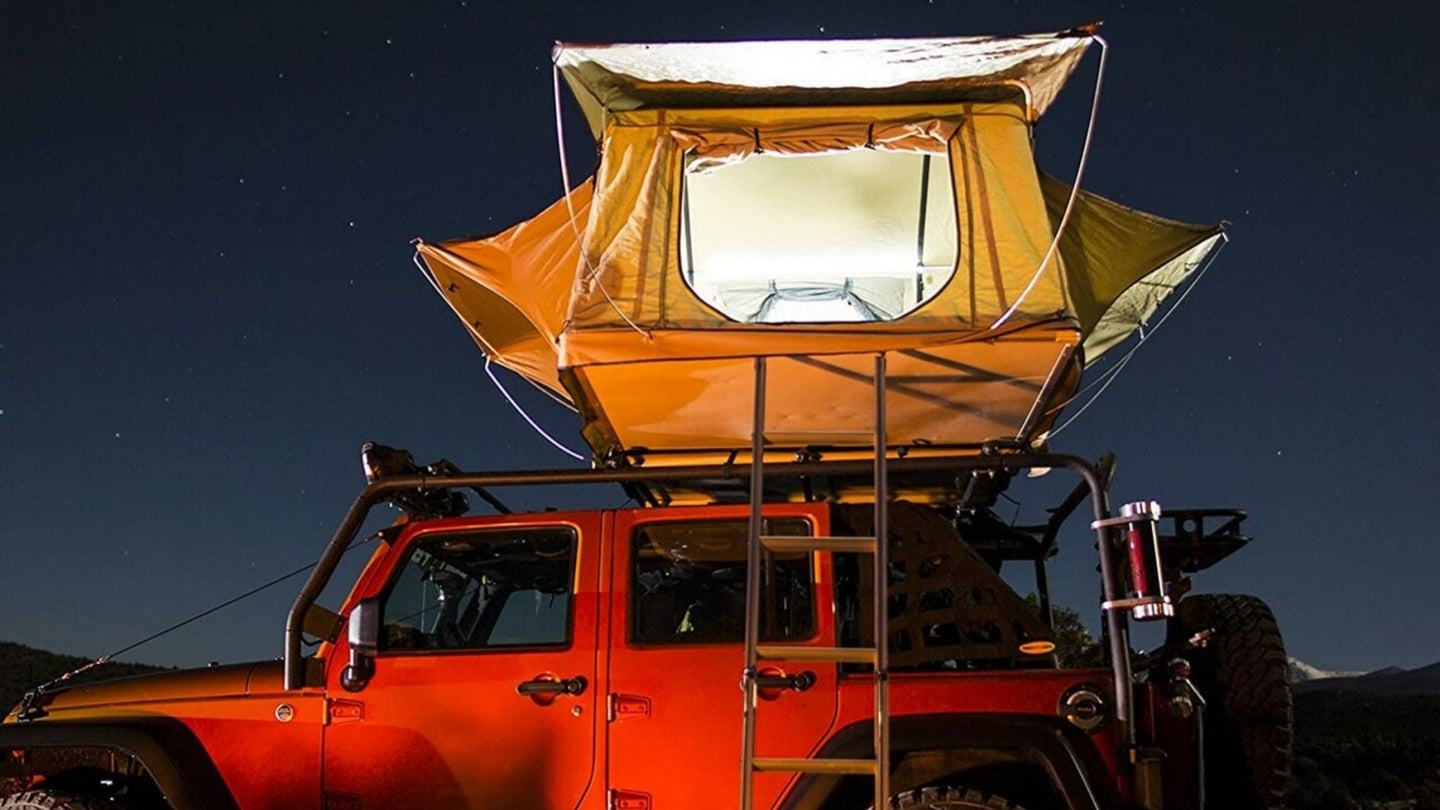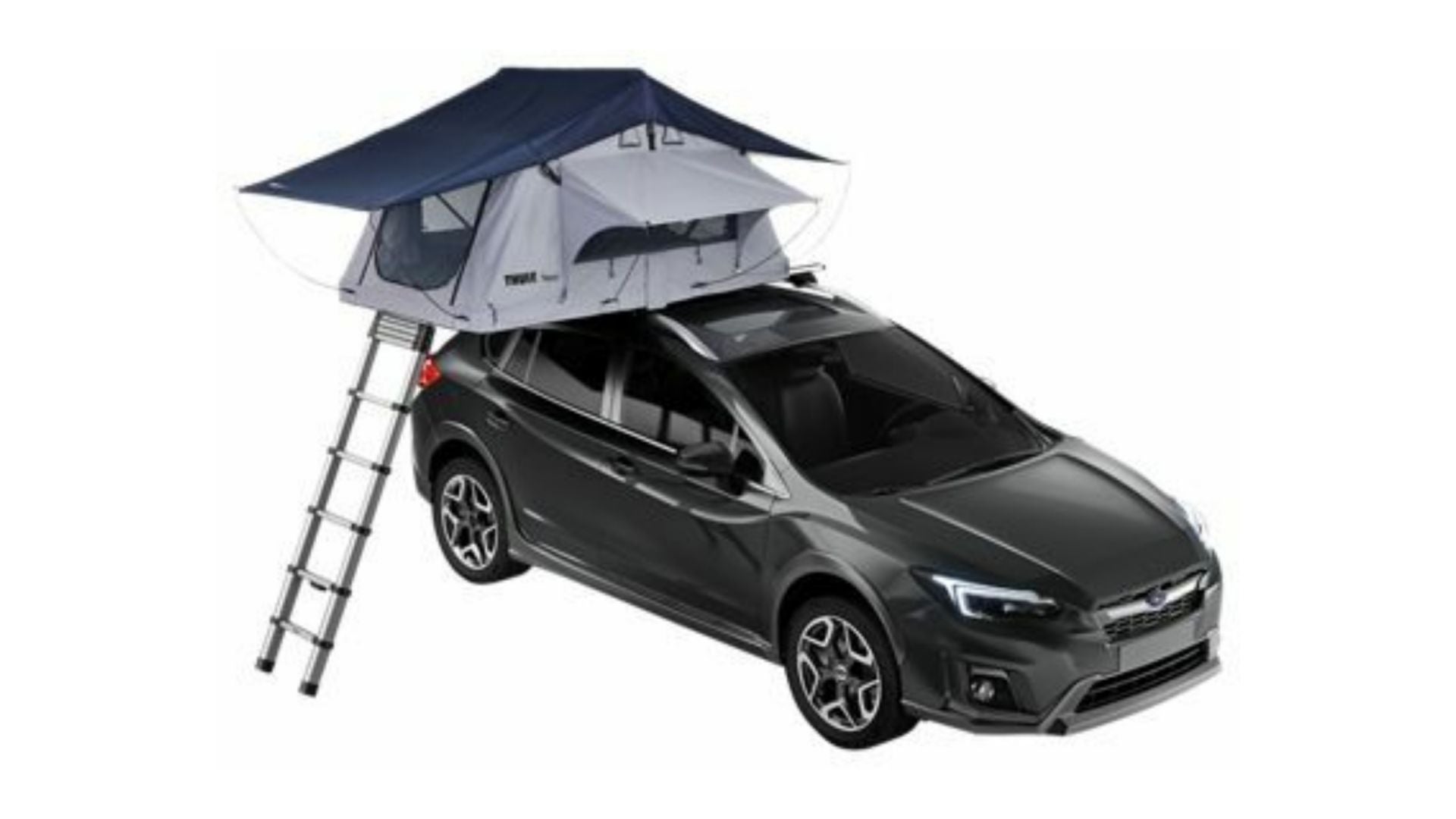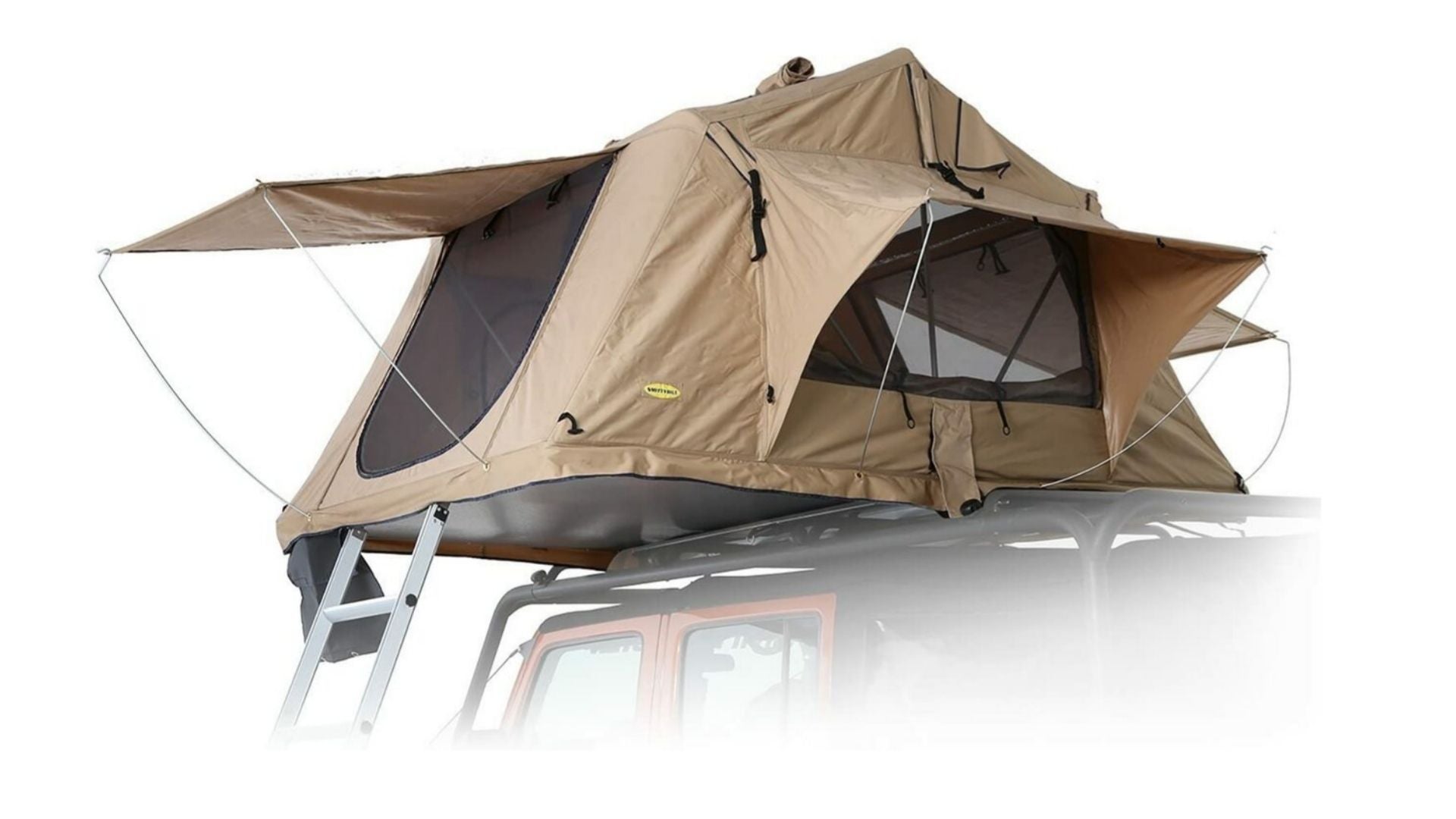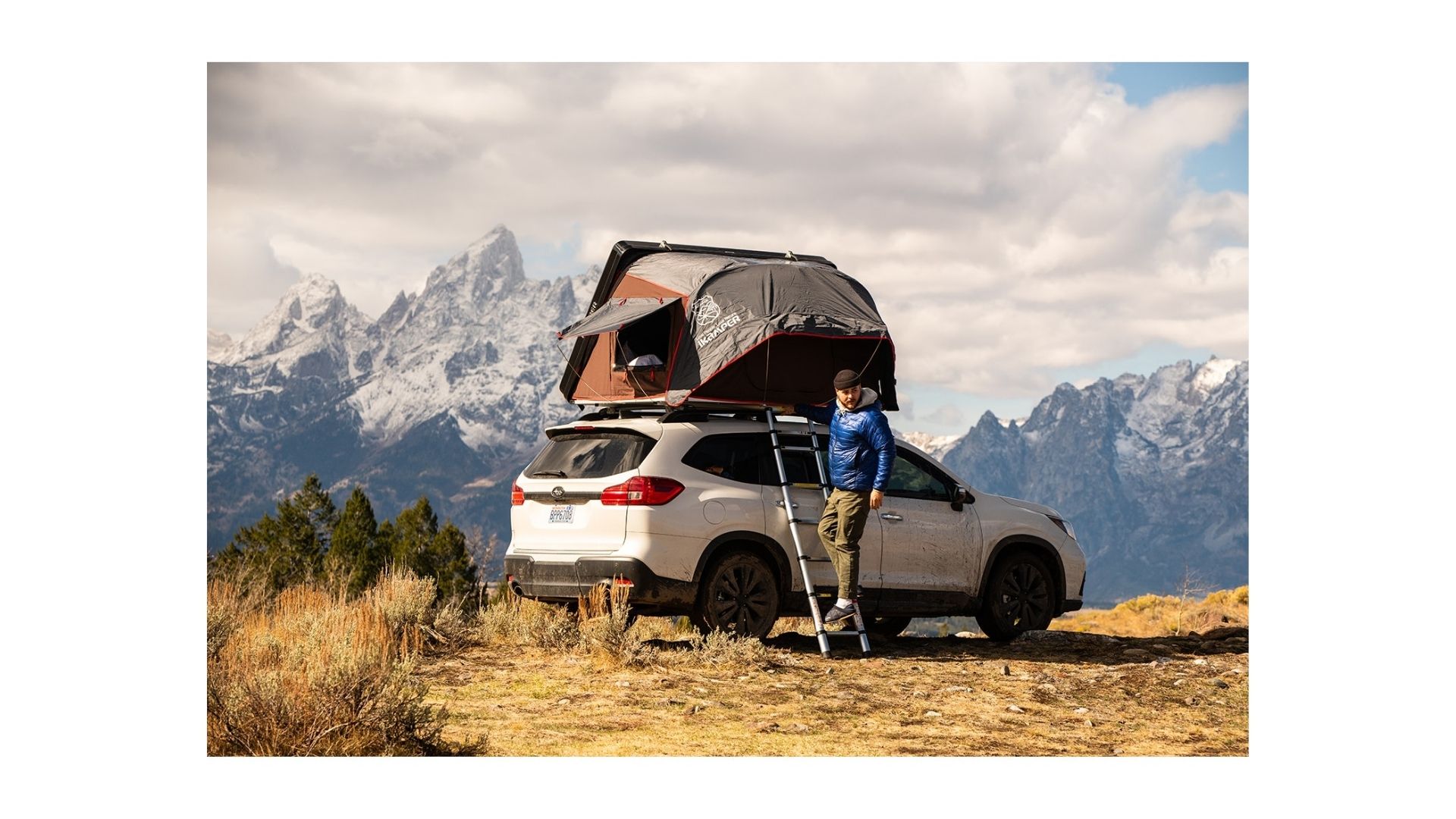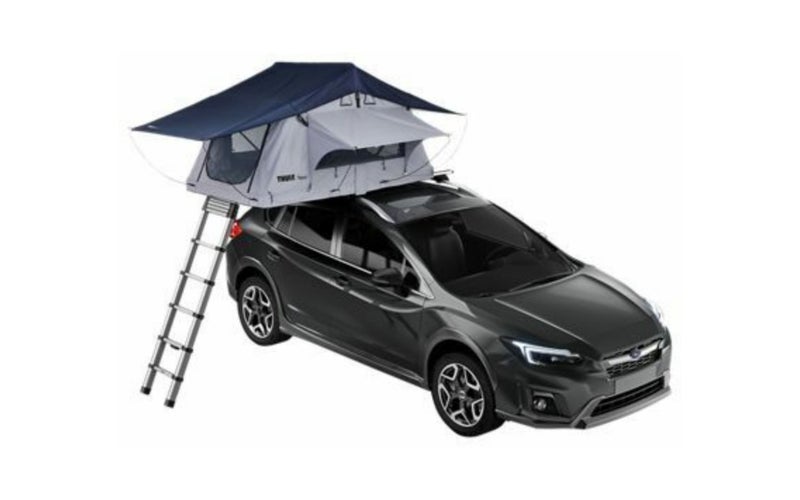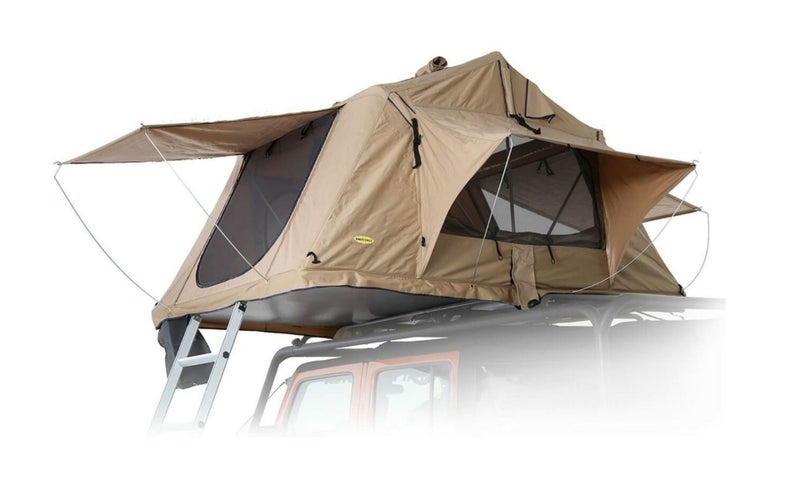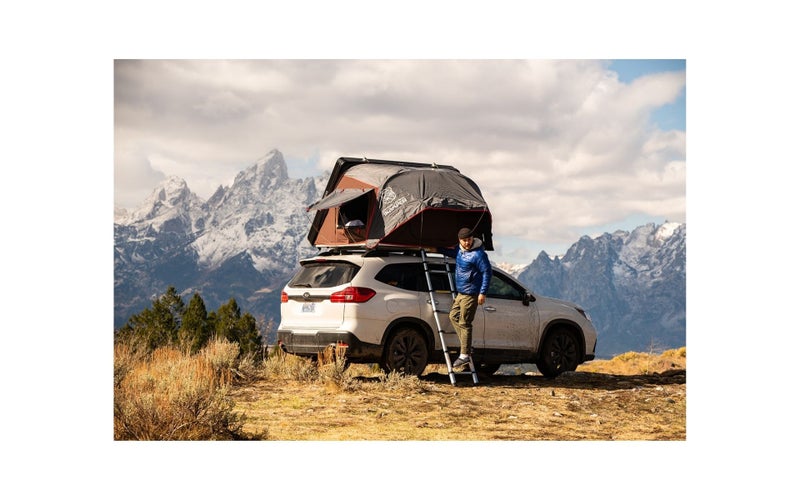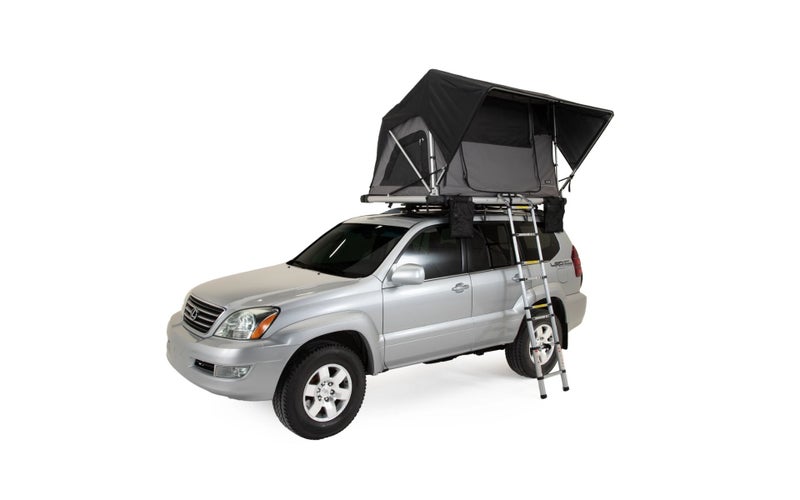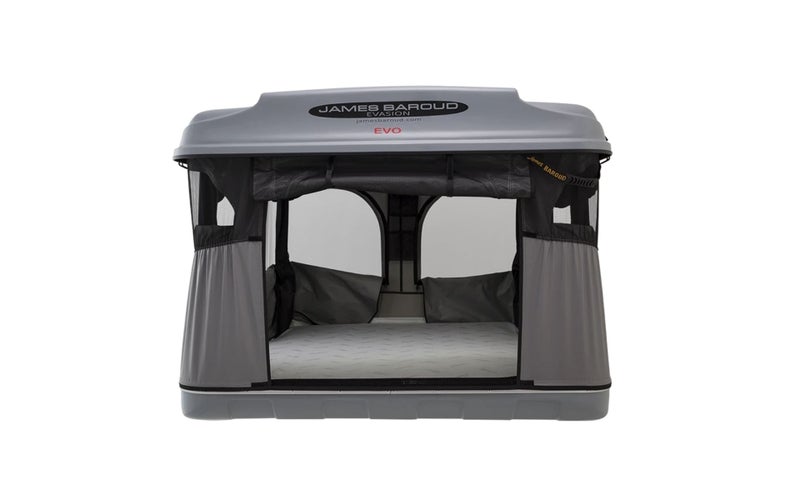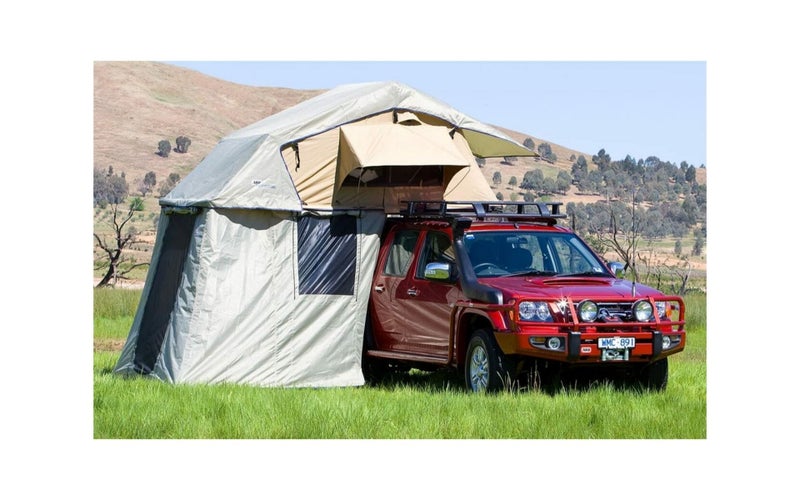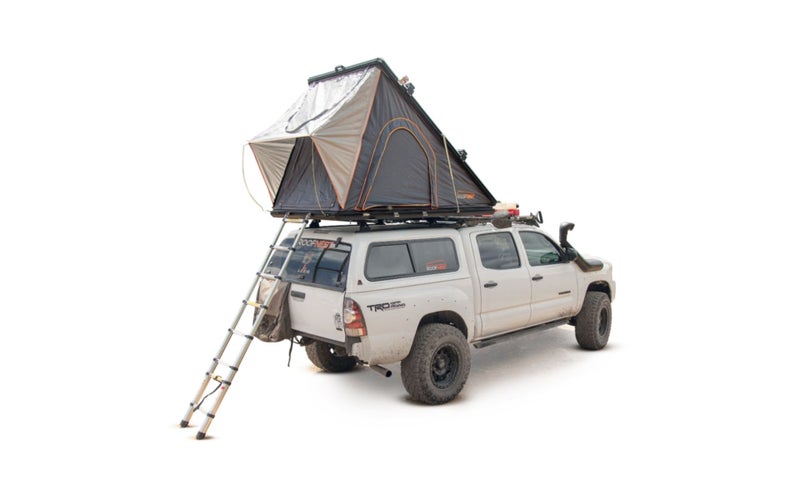We may earn revenue from the products available on this page and participate in affiliate programs.
Some of you are in a real pickle right now. Camping is great, we all agree. But what if hiking and schlepping a week’s worth of gear is not so spectacular? Car camping is the perfect solution. It’s also a perfect excuse to load up on all kinds of tires, winches, coolers, and camping grills.
One of the best (and definitely one of the coolest) ways to upgrade your vehicle is to add a rooftop tent. These pieces of kit work great on trucks and rugged SUVs, but they’re just as cool on smaller cars. They’re impossibly rad on wagons, by the way.
Rooftop tents aren’t cheap, but you get what you pay for and the investment can give you years of unforgettable outdoor adventures. There’s a lot of information to digest before you punk down your cold, hard cash, so we’re going to break it all down for you, complete with a few of our favorite picks.
Thule has been a dominant force in the car accessory business for a long time, and the powerhouse wasn’t about to let the rooftop tent market get away from it. The Tepui Explorer Ayer 2 is all about convenience, from installation to daily use.
Take the guesswork out of mounting this to your vehicle with a full suite of Thule components that were designed for your car. Knowing that every piece is backed by Thule’s reputation and warranty is great for peace of mind, and the level of build quality is as good as you’d expect.
This jack-of-all-trades is sure to satisfy most car campers. There are better options for hardcore overlanders, and the mattress might wear out its welcome on longer trips, but it’s hard to think of a reason why this one wouldn’t be in the running for your next purchase.
- Sleeps: Two people
- Weight: 105 pounds
- Closed size: 42 inches wide x 48 inches long x 11 inches high
- Open size: 84 inches wide x 48 inches long x 39 inches high
Nylon where you need it, cotton where you want it
Built-in storage is a considerate feature
Compatible with all kinds of Thule accessories
Not overly aggressive in the styling department
Pack a sleeping pad to supplement the mattress
Climbing up to install the rain fly is a chore
No excess of interior space
Check out most of the rooftop tents you see on the trail, and there’s a good chance most of them will be the Smittybilt Overlander. The perennial favorite is easy on the wallet without feeling cheap.
The Overlander looks like it was built for an African safari, and it wouldn’t be a bad choice for one if you ask us. The 600-denier nylon shell is rugged, waterproof, and fits into the environment with a natural shade of tan. If you want extra space, an annex tent can be purchased separately and a larger size is available.
Sure, build quality isn’t quite what you’d get from the other rooftop tents on this list but, for a third of the price, we think that’s acceptable.
- Sleeps: Three people
- Weight: 117 pounds
- Closed size: 47 inches wide x 55 inches long x 12 inches high
- Open size: 95 inches wide x 56 inches long x 51 inches high
Priced for the people
Loads of interior space
Sunshades and mosquito netting for the windows
Add a downstairs annex for more room
Noticeable step down from premium brands
Can get noisy in windy conditions
Soft cover isn’t great for fuel economy
There’s a lot of debate among campers when it comes to hard shells and soft shells, but the iKamper Skycamp 2X does a surprisingly good job of offering the best of both worlds. If you can justify the cost of entry, it’s an awesome option.
Underneath that hard shell is a clever design that makes the most of this tent’s footprint to provide usable headroom from edge to edge. It allows enough ventilation for summer nights and can stay warm through the winter with the quilted liner installed. If you plan on doing a lot of cold-weather camping, a second layer of insulation is available.
This blend of features and four-season practicality make the Skycamp 2X a winner in our book.
- Sleeps: Two people
- Weight: 120
- Closed size: 51 inches wide x 76 inches long x 13 inches high
- Open size: 51 inches wide x 76 inches long x 48 inches high
Compromise between hard and soft shells
That insulation warms our souls
You might not feel the aerodynamics, but your wallet will
Build quality is top-notch
All those perks aren’t cheap
Can be a bit of an origami project
Might be overkill for a lot of campers
If you’re looking for a soft-shell rooftop tent to take your adventures to the next level, it’s hard to argue against this one from Freespirit Recreation. It delivers a level of quality that goes beyond what the price tag suggests.
Once the soft cover is removed, the simple design allows this tent to roll upright in seconds. The black rain fly shields you from rain and snow while the quilted lining keeps temperatures comfortable during colder camping trips. Entry and exit are aided by the oversized door, and mesh pouches keep your belongings organized.
Two sizes are available, and FSR also offers a matching annex to add more space alongside your vehicle. Check out the company’s catalog of accessories for even more customization options.
- Sleeps: Three people
- Weight: 118 pounds
- Closed size: 60 inches wide x 85 inches long x 9 inches high
- Open size: 55 inches wide x 80 inches long x 47 inches high
Setting up and tearing down could not be easier
Store shoes outside with hanging pockets
Enjoy the view through windows on all sides
Trick yours out with an extra liner and annex
Be mindful of exposed metal hinges
Doesn’t expand as much as other soft-shell tents
Makes the rest of your gear feel overly complicated
If your standards prevent you from anything less than five-star accommodations, please allow us to direct you to the James Baroud Evasion. This rooftop tent defies the notion that you can’t fit a luxury hotel on top of your car.
Let’s start with the mattress, shall we? It’s three inches of foam with a washable cover. Lighting comes courtesy of a rechargeable ceiling light because you shouldn’t have to suffer the indignity of wearing a headlamp. A solar-powered ventilation system keeps filtered air flowing so this tent stays fresh. Wrap it all up with a fiberglass roof and panoramic windows.
Is this pushing the boundaries of what constitutes camping? Probably, but you won’t hear us complaining about it.
- Sleeps: Three people
- Weight: 145 pounds
- Closed size: 55 inches wide x 79 inches long x 13 inches high
- Open size: 55 inches wide x 79 inches long x 39 inches high
Get your beauty rest on this plush mattress
Solar-powered ventilation? Are you kidding?
Gas struts raise the lid automatically
Tested in winds up to 60 miles per hour
We’ve owned vehicles that cost less
Weirdly enough, we don’t love the ladder
Does this even count as camping?
Load up the whole family because the Simpson III rooftop tent from ARB has room for everyone. Alternatively, take it for a solo trip and enjoy all the room for activities.
This soft-shell tent is the king of square footage on this list, thanks to its open width of 95 inches and a downstairs annex for another camper or all your gear. Thoughtful features like four exterior shoe pouches and vents for fresh air make this a great option for getting the family out of the house.
As a result of this tent’s size and shape, you’ll need a fair bit of room to set it up and strong wind might be more noticeable. But what do you expect? It’s basically a camping condo.
- Sleeps: Three people
- Weight: 154 pounds
- Closed size: 55 inches wide x 47 inches long x 12 inches high
- Open size: 55 inches wide x 95 inches wide x 51 inches high
Includes a double-decker annex
Cost-effective way to shelter several people
Packs up surprisingly small
Ladder pokes out of the bottom like a treehouse
Is having everyone in one tent a good thing?
Installation can be tricky
Mattress is a loose term in this case
Roofnest came to win with the Falcon. This hard-shell tent boasts tons of headroom and hard mounts for storing gear on the roof.
Despite a peak height of 60 inches, the Falcon folds down to a closed height of 6.5 inches to make it the slimmest tent on this list. The steep, aluminum shell creates an incredibly durable roof and mounting point for up to 50 pounds of extra gear on each side. Storage pockets and a massive cargo net keep things nice and organized inside.
Aerodynamics might be the Falcon’s claim to fame, but there are a lot of other reasons to love this rooftop tent. If you have lots of equipment to carry and a little room in your budget, it’s a very solid choice.
- Sleeps: Two people
- Weight: 140 pounds
- Closed size: 50 inches wide x 90 inches long x 7 inches high
- Open size: 50 inches wide x 90 inches long x 60 inches high
Add a roof rack to the roof of the tent
Highest peak of any tent here
No shortage of interior storage
Aluminum construction makes the shell light and strong
One of the larger footprints out there
Premium price might be out of reach for some campers
Hinged lid blocks the view to the front
Why you should trust us
We pride ourselves in providing expert analysis on all kinds of tactical, survival, and outdoor adventure gear. Want a down-and-dirty guide to everything you need for a great camping trip? We’ve got you covered. How about a bug out bag for the worst-case scenario? Yep, we can help with that, too. We have more than a few gearheads on our team, so jumping into the overlanding game was only natural. It doesn’t matter if you’re contemplating prepping your 4×4 for a cross-country expedition or taking a weekend vacation in your subcompact economy car, we’ve had the same thoughts and have probably acted on them. Let us be the bad influence you need to build your rig to handle anything up to and including the zombie apocalypse.
Types of rooftop tents
Rooftop tents are pretty straightforward, but there are a few key differences that can help you narrow down your search. The most obvious requirement is size. You’ll need to find something that fits your needs and your vehicle. Tent construction plays a role too, so pay attention to how each one goes from folded-up to ready-to-use. There are also accessories available to customize your rooftop tent, so factor that in when you’re making your initial purchase.
Soft shell vs. hard shell
Soft-shell rooftop tents are basically traditional tents that mount to your car. They’re relatively light and easy to set up compared to their hard-shell alternatives. They also breathe well and stay cooler during the summer. On the other hand, they’re nowhere near as durable or aerodynamic as a slick, hard-shell tent.
Having a hard shell on your rooftop tent adds protection against the elements, whether you’re parked for the night or blasting down the highway. Although they tend to be heavy, they make up for it to some degree with improved aerodynamics. Let’s be honest, any rooftop tent is going to have a negative effect on your fuel economy.
Both styles are viable options, so do a little digging if you still aren’t sure which is right for you.
Pop up vs. fold out
How your tent goes about its butterfly-like transformation also has an effect on the amount of real estate you’re left with. Pop-up tents are a snap to set up because they just extend vertically. When you’re ready to go, just collapse the walls and attach the roof to the floor. This means that what you see is what you get in terms of floor space.
Fold-out tents offer much more floor space––think double. This structural origami is more complicated than the alternative and constrains you to soft-shell designs, but you’ll benefit from much more space, both in terms of square footage and headroom. If you camp with a group, this is the way to go.
Add-ons
As is tradition, there’s also way more gear to acquire. Annex tents add enclosed space beneath a fold-out tent, which is great for storage or getting dressed. Some are large enough to sleep in, so you can bring more friends as long as someone’s willing to call dibs on the bottom bunk. Annexes are generally tent-specific.
Awnings add protection from the sun and rain. They’re usually compatible with a range of rooftop tents, and sometimes can be used on their own. Setting them up is as easy as unrolling them and attaching a pole at the two outer corners. Some even have screens to keep the bugs away.
Key features of rooftop tents
Weather protection
The reason we use tents in the first place is to get out of the elements. Some rooftop tents do that better than others. Hard-shell tents offer more protection against rain, snow, and falling branches. Soft-shell tents are more akin to traditional tents both in terms of limited weather resistance and weight.
A unique benefit of rooftop tents is getting you off the ground. That’s a big help during heavy rain that could flood your campsite and it takes the stress out of finding a patch of ground that’s smooth and flat enough to be comfortable. If you camp in an area where wildlife is a factor, being perched on a vehicle can add some peace of mind.
Ladder
Being elevated off the ground means you won’t be crawling into your tent like you’re used to. Instead, every trip in and out will involve a ladder. Manufacturers have accounted for different vehicles by providing telescoping ladders that can accommodate everything from compact cars to lifted trucks.
As you can imagine, this has an effect on convenience. If you like to camp with pets, be prepared to lift them into and out of the tent. Compliance is not guaranteed. Every midnight trip to the bathroom will also involve a groggy climb down and back up the ladder. It just comes with the territory.
Everyday practicality
Mounting a rooftop tent to your vehicle isn’t difficult, but it’s not something we’d want to do very often. Even if the weight is easy for you to lift, the awkward size of rooftop tents is a lot easier to handle with a helper. Your vehicle’s paint will appreciate it, too. As a result, many people install their rooftop tent once and leave it in place year-round.
The extra weight and aerodynamic drag take a toll on fuel economy and may limit where you can park taller vehicles. Make sure you take that into consideration. Some truck owners mount their tents low over the bed so they can save on gas and fit into their garage.
Benefits of rooftop tents
Easy setup and tear-down
Compared to setting up a traditional tent, we’d argue that getting a rooftop tent ready for action is actually easier. Pop-up and fold-out tents are pre-assembled and ready to open in just a few minutes––or less. Many even have a mattress (or maybe sleeping pad is more accurate) that stays in place and is ready as soon as the tent is raised. Tearing the tent down is just as easy and there are no poles and stakes to keep track of.
We also appreciate not having to sweep the ground for rocks and sticks, only to find that what feels like level ground while standing is noticeably sloped once we lay down. Rooftop tents are always flat on the bottom, and your vehicle’s suspension does wonders to create a level foundation.
Extra security
Some people feel that crawling into a sleeping bag in a tent is a lot like creating a human burrito for bears. Rooftop tents are far from animal-proof, but the elevation adds a layer of security against pesky critters. Animals—especially creepy crawlies—are less likely to mess with you if they have to climb your vehicle to get to you.
The added height is also reassuring to some people. Sleeping on your vehicle’s roof puts you at eye-level with other people and above most four-legged friends. Maybe it’s all in our heads, but we can see why some people feel better about sleeping up high.
High-rise living
If Instagram tells us anything, it’s that camping is basically just an excuse to post pictures of your hiking boots sticking out of your tent with a breathtaking view in the background. Rooftop tents are absolutely killing it in the influencer world, but you can also enjoy the view without feeding your digital addiction.
There’s a reason people pay more for apartments and hotel rooms on the top floor. The view is just better from up there, and rooftop tents are no different. There’s something just a little more magical about opening your tent flap to a high-rise view of your favorite national park––with or without the hashtags.
Pricing considerations for rooftop tents
Budget
There are two types of products you’ll see sold for less than $1,000. The first is budget rooftop tents. These might work for people on a tight budget, but the build quality is going to be hit-or-miss and we can’t necessarily vouch for all of the manufacturers. If you’re planning a casual outing once or twice a year, there’s nothing wrong with giving these a try. If you’re planning an off-road run from the Great Salt Lake to Lake Tahoe, you better level up.
The other type of products you’ll see are accessories for higher-end rooftop tents. This includes annexes and awnings that add to the overall footprint of your shelter. They can be really nice to have. Some can be used on their own, but others need to be attached to an existing rooftop tent.
Mid-range
Most of the rooftop tents you’ll see on this list cost somewhere between $1,000 and $3,000. Most of these are soft-shell tents. Sticking to fabric construction keeps weight down and can make setting your tent up easier. Some people also prefer the more conventional feel of these tents.
You can also find a few hard-shell rooftop tents in this price range. These offer more protection, both for you while you sleep and for the tent while you’re driving. Weight starts to become more of an issue here, so make sure your vehicle and roof rack are up to the task.
Premium
If you have more than $3,000 to spend on a rooftop tent, you can get some seriously tasty gear. We’re talking about some of the most hardcore, expedition-ready equipment out there. Build quality is top-notch and the accessory catalog is chock full of goodies to customize your rig.
To justify this kind of spending, you’ll need to use your rooftop tent regularly––and for more than overnights at your local campground. That’s fine with us, because it’s a great excuse to burn those vacation days you’ve been hoarding and hit the trail with a few friends, a map, and cans of extra gas. Lots of extra gas. Double what you think you need.
How we chose our top picks
There are a lot of companies trying to cash in on the outdoor adventure market, and all products are not created equal. We tapped into our network of overlanding experts who have countless collective trips into the desert and frozen north using rooftop tents. These campers have real-world experience with all kinds of gear ranging from rooftop tents to locking axles. By consolidating their experience and our own market knowledge, we gathered some of the best options for this gear guide. Everything here is something we’d personally want to use.
FAQs on rooftop tents
You’ve got questions, Task & Purpose has answers.
Q. What are the benefits of rooftop tents?
A: Rooftop tents are popular because they’re easy to set up in a short amount of time. They also get your sleeping area off the ground which adds a layer of protection against water and wildlife. The views aren’t bad, either.
Q. What are the drawbacks of rooftop tents?
A: Rooftop tents are more awkward to get in and out of because you have to climb a ladder. They also require you to keep your vehicle parked once they’re up. Cost is another disadvantage compared to ground tents, but you may find that the pros outweigh the cons.
Q. Can I put a rooftop tent on my car?
A: You bet! Rooftop tents are built to mount on roof racks, not the roof itself. As long as you have an adequate support structure, you can mount a rooftop tent to your car. As always, check with the manufacturer if you have any concerns.
Q. Why are rooftop tents so damn expensive?
A: Rooftop tents are a lot more complicated to build than traditional tents. You also have to remember that they’re in use all the time. Even when a rooftop tent is collapsed, it’s still subjected to high speeds and the elements as long as it’s on your vehicle.
Q. How sturdy are rooftop tents?
A: Rooftop tents are tough by design. They’re very compact when collapsed, and there isn’t that much stress on them when they’re popped up. The weak point could very well be the roof rack you mount them on.
Our gear section
Scott Murdock is a Task & Purpose commerce writer and Marine Corps veteran. He’s selflessly committed himself to experiencing the best gear, gadgets, stories, and alcoholic beverages in the service of you, the reader.
